|
|
|
Sort Order |
|
|
|
Items / Page
|
|
|
|
|
|
|
| Srl | Item |
| 1 |
ID:
120026
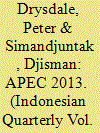

|
|
|
| 2 |
ID:
076124
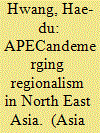

|
|
|
| 3 |
ID:
125322
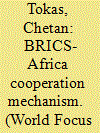

|
|
|
|
|
| Publication |
2013.
|
| Summary/Abstract |
The acronym BRICs, coined by Jim O'Neill, chief economist of Goldman Sachs in 2001 so as to describe the anatomy of four largest developing economies of the world - Brazil, Russia, India and China has graduated to a new level after inclusion of The Republic of South Africa in 2010. With this latest entry, BRICS has developed into one of the strangest and an impressive group in recent years of global politics.
|
|
|
|
|
|
|
|
|
|
|
|
|
|
|
|
| 4 |
ID:
148695
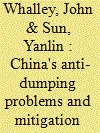

|
|
|
|
|
| Summary/Abstract |
The present paper explores the opportunities for China's regional trade agreement (RTA) initiatives to mitigate its anti-dumping problems. The paper highlights the severity and discriminatory nature of China's anti-dumping problems. The high concentration of the share of anti-dumping actions taken by the top 4 and top 8 anti-dumping initiators is noted. Our finding of a weak effect of existing RTAs on mitigating China's anti-dumping problems supports the argument that China could become more active in mitigating anti-dumping problems through RTA negotiations. An RTA can include a higher level of openness in exchange for an improvement in regional anti-dumping provisions. Case studies on RTAs involving the EU, the USA and India offer some precedents for offering inducements and modifying regional anti-dumping provisions. The approaches for China may lie in obtaining market economy status from intensive anti-dumping initiators at RTA levels and also altering regional anti-dumping provisions that could be put in place in exchange for some potential concessions.
|
|
|
|
|
|
|
|
|
|
|
|
|
|
|
|
| 5 |
ID:
144159


|
|
|
|
|
| Summary/Abstract |
Central Asian food processors face a number of constraints when they attempt to export to the region and beyond. The Central Asian economies in focus here are landlocked, and thus lack easy access to sea transport. In addition, the region's transport network was built to reinforce the interdependence of the then Soviet republics, while conflicting economic interests make cross-border cooperation difficult. Based on extensive fieldwork on infrastructure systems and firm export strategies, this paper identifies contemporary infrastructure and transportation issues within the Central Asian region, and makes a novel attempt to examine how these factors lead to challenges for local food processing producers trying to sell their products in the region and beyond.
|
|
|
|
|
|
|
|
|
|
|
|
|
|
|
|
| 6 |
ID:
151887
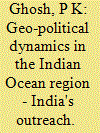

|
|
|
| 7 |
ID:
163570
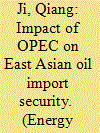

|
|
|
|
|
| Summary/Abstract |
East Asian countries, such as China, Japan and South Korea, are major importers in the international oil market. Therefore, oil import security is critical to sustainable economic development in these countries. This paper uses a modified two-stage DEA-like model to investigate the impact of the Organization of Petroleum Exporting Countries (OPEC) on oil import security in the East Asian region over time. Specifically, three dimensional variables were introduced to the model: the OPEC internal dimension, the OPEC and Asian country interaction dimension, and the international external dimension. The empirical results show a substantial difference between China and the other two countries in terms of these dimensions. Although the impact of OPEC on China's oil security has increased over time, its impact on Japan has declined. Political uncertainty in OPEC countries and oil price volatility are the major issues for China, whereas cost is the key area of concern for Japan. South Korea's concerns are less clear. The results of this study lay an important foundation for discussing policy issues involved in regional cooperation, integration and sustainable growth in the East Asian region.
|
|
|
|
|
|
|
|
|
|
|
|
|
|
|
|
| 8 |
ID:
098099
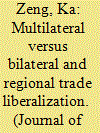

|
|
|
|
|
| Publication |
2010.
|
| Summary/Abstract |
In recent years, at the same time it has pursued multilateral trade negotiations via membership in the World Trade Organization (WTO), China has embraced a regional approach to trade liberalization by negotiating a number of bilateral or regional free trade agreements (FTAs) with its trading partners. This paper examines China's increasingly active FTA diplomacy and seeks to explain China's motives for pursuing expanded FTAs. Specifically, this paper argues that while China's FTA activism reflects considerations about enhancing China's influence in the Asia-Pacific region, capturing the economic gains of FTA participation, and minimizing the trade and investment diversion resulting from the competitive dynamics of regional trade liberalization, the move toward expanded FTAs is also consistent with the desire to create alternative bargaining forums over trade issues that could help to stabilize expectations as well as the need to use FTAs to control the pace of trade liberalization so as to accommodate protectionist pressure emanating from domestic interest groups. In particular, this paper highlights the impact of domestic politics on China's FTA negotiations through a detailed discussion of how pressure from protectionist seeking interests influences the scope and depth of China's FTAs.
|
|
|
|
|
|
|
|
|
|
|
|
|
|
|
|
| 9 |
ID:
137227
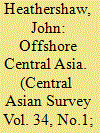

|
|
|
|
|
| Summary/Abstract |
For the first two decades of independence, most academics and policy analysts viewed Central Asia as detached from the global economy and immune to the diffusion of globalization trends. The apparent failure of ‘transition’ – allegedly manifest in high levels of corruption, elite control of critical industries and assets, and low levels of formal intra-regional trade – has been interpreted as further evidence of Central Asia's distance from the world economy and has led to new initiatives to bridge the gap. This is most evident in US State Department's recent vision of creating a New Silk Road that would increase trade and infrastructure linkages between Afghanistan and the Central Asian states.
|
|
|
|
|
|
|
|
|
|
|
|
|
|
|
|
| 10 |
ID:
094037
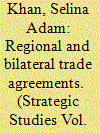

|
|
|
| 11 |
ID:
134110
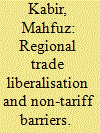

|
|
|
|
|
| Publication |
2014.
|
| Summary/Abstract |
Although trade liberalisation measures are in place for eight years, intraregional trade in South Asia has been meagre and is not encouraging at all as Bangladesh's export market in the region. India also granted duty free quota free access to almost all traded Bangladeshi products, which is also not showing significant increase in Bangladesh's export to reduce the country's mounting trade deficit with India. Therefore, overwhelming presence of non-tariff barriers has been perceived to be resulted in intra-regional trade significantly lower than expected. Given this context, the paper tries to identify the non-tariff barriers in South Asia in the context of Bangladesh's export expansion in this region. It takes a few product-specific cases in both export and import of Bangladesh to examine the barriers prevailing in neighbouring countries, viz. India, Nepal and Bhutan. The paper reveals that such barriers are related to bonded warehouse, gate pass, shipment and customs, infrastructure in land customs stations, visa, speed money, and excessive checking, which have been suggested to constrain expected gains from regional trade liberalisation measures. The paper argues that India's countervailing duty on garments import has not impacted negatively on Bangladesh's exports, but there is scope for further improvement if the duty is set equally for Indian and foreign manufacturers.
|
|
|
|
|
|
|
|
|
|
|
|
|
|
|
|
| 12 |
ID:
116402


|
|
|
|
|
| Publication |
2012.
|
| Summary/Abstract |
Turkey's economic ties with neighboring Arab countries have flourished in the past few years. A recently stated pledge to create a regional trade alliance with Turkey, Syria, Lebanon and Jordan is likely to trigger a further expansion of economic integration. This paper starts by reviewing trends in Turkey's bilateral trade relations with Syria, Lebanon and Jordan since 2000. Next, it estimates a formal gravity model aiming to project Turkey's trade potential with its neighbors and compare them with the actual flows in 2000-10. It is demonstrated that while Turkey fully realized its bilateral trade potential vis-à-vis Syria, Lebanon and Jordan, actual bilateral trade of Syria, Lebanon and Jordan with Turkey is significantly below the estimated potential.
|
|
|
|
|
|
|
|
|
|
|
|
|
|
|
|
| 13 |
ID:
174912
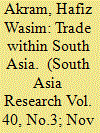

|
|
|
|
|
| Summary/Abstract |
This article analyses the causes of low intra-regional trade connections within South Asia, which have remained disappointing despite the long-awaited launch of the South Asian Free Trade Area (SAFTA) on 6 January 2004 in Islamabad. Analysis of World Bank data and other relevant sources for the period 1995–2018 shows that trade among SAFTA members has not increased as significantly as had been hoped. The statistical analysis undertaken confirms what was suspected by many observers, as it shows that the SAFTA countries are not actually natural trading partners. Rather they are often competitors, seeking to export the same product groups. Since this makes the prospects of future substantial increase in mutual trade unlikely, the article concludes with some reflections about how to strengthen regional trade support mechanisms.
|
|
|
|
|
|
|
|
|
|
|
|
|
|
|
|
| 14 |
ID:
108920
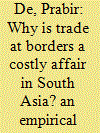

|
|
|
|
|
| Publication |
2011.
|
| Summary/Abstract |
Through the agreement on the South Asian Free Trade Area (SAFTA), South Asian countries are now looking towards deeper integration of the region. Nevertheless, South Asia is far from realising its full potential. The econometric evidence provided in this article strengthens the existing linkage of trade costs, transit and trade flows; the higher the transaction costs between each pair of trade partners, the less they trade. The analysis given in this article shows that improved trade facilitation would enhance regional trade very much the same way tariff liberalisation does. This article also suggests that an important means of promoting regional trade could be improved trade facilitation, which will not only enhance regional trade but will also strengthen the trade capacity of the landlocked countries.
|
|
|
|
|
|
|
|
|
|
|
|
|
|
|
|
|
|
|
|
|